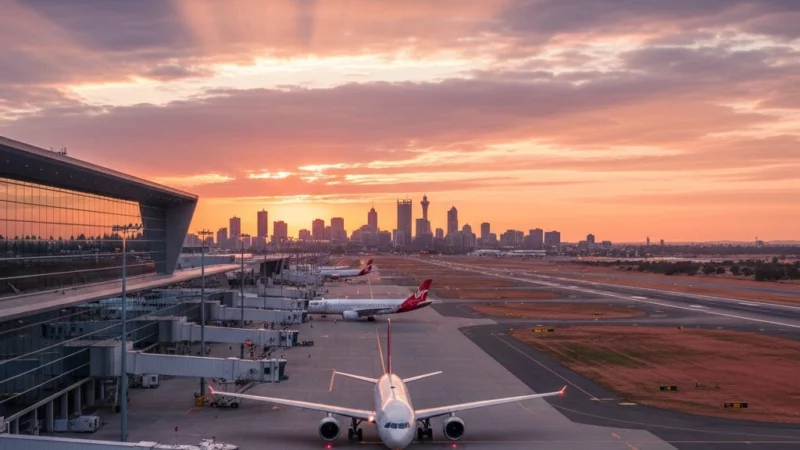Perth Airport

Perth Airport (IATA: PER, ICAO: YPPH) is the main international and domestic airport serving Perth, the capital city of Western Australia. Located approximately 12 kilometers east of the Perth central business district (CBD) in the suburb of Redcliffe, it is the fourth busiest airport in Australia in terms of passenger traffic and aircraft movements. Perth Airport serves as a key hub for domestic flights across Australia and international flights to Asia, the Middle East, and Europe.
History
Perth Airport was originally established in 1938 as Maylands Aerodrome, serving small domestic flights. The current site at Redcliffe began operations in the 1940s, gradually replacing the older facility. Over the decades, the airport has expanded with the addition of domestic and international terminals, modernizing its infrastructure to handle increasing passenger volumes. Key developments include the construction of the international terminal in 1992 and continuous upgrades in the 21st century aimed at improving passenger experience and sustainability.
Terminals
Domestic Terminal
The Domestic Terminal is located in Terminal 1 and caters primarily to Australian airlines, including Qantas, Virgin Australia, and Jetstar. Key facilities include check-in counters, self-service kiosks, baggage claim areas, dining outlets, retail stores, lounges, and car rental services.
International Terminal
The International Terminal, also part of Terminal 1, handles flights to destinations across Asia, the Middle East, and Europe. Facilities include customs and immigration, duty-free shops, lounges, currency exchange, and passenger services.
How to Reach
Perth Airport is easily accessible from the Perth metropolitan area through multiple transport options suitable for both domestic and international travellers.
By Car
- The airport is connected via major highways including Tonkin Highway, Roe Highway, and Great Eastern Highway.
- Travel time from Perth CBD is approximately 20–25 minutes, depending on traffic.
- Clear signage directs drivers to all terminals, parking areas, and drop-off zones.
By Public Bus (Transperth)
- Transperth operates several routes connecting Perth Airport to key suburbs and the CBD.
- Route 380 runs between Elizabeth Quay Bus Station (Perth CBD) and Terminal 1 (International).
- Route 40 connects the airport to Kings Park and Perth City, serving Terminals 3 and 4.
- Buses run frequently, and Myki/SmartRider cards are accepted.
By Airport Shuttle
- Shuttle buses are available from select hotels and major transit hubs.
- These services offer a convenient option for passengers with luggage or those staying in nearby suburbs.
By Taxi
- Taxis are available 24/7 from designated ranks outside all terminals.
- A typical ride from Perth CBD to the airport costs AUD 35–50, depending on traffic and time of day.
By Rideshare
- Uber, Ola, and DiDi operate at Perth Airport with dedicated pick-up areas.
- Rideshare is a popular choice due to its flexibility and transparent fare structure.
By Car Hire
- Major car rental companies, including Hertz, Avis, Budget, Europcar, and Thrifty, have desks located inside all terminals.
- Pre-booking is recommended during peak travel seasons.
By Bicycle
- Dedicated cycling paths connect parts of Perth’s eastern suburbs to the airport precinct.
- Bicycle racks are available near select terminal areas.
Airlines and Destinations
Perth Airport offers connectivity to major domestic cities and international hubs including Singapore, Kuala Lumpur, Doha, Dubai, Hong Kong, and Bali. It serves as a hub for Qantas and Virgin Australia.
Facilities
Facilities include free Wi-Fi, lounges, dining options, retail outlets, accessibility services, car rental desks, and extensive parking options such as short-term, long-term, and premium bays.
Cargo Operations
The airport handles substantial cargo traffic, supporting Western Australia’s mining, agriculture, and pharmaceutical sectors. Dedicated cargo terminals ensure efficient freight movement.
Safety and Security
Perth Airport follows stringent safety protocols aligned with CASA and ICAO standards, including advanced passenger screening, surveillance systems, and airport security patrols.
Future Developments
Planned upgrades include terminal expansions, improved transport connectivity, solar energy integration, and more passenger-friendly facilities aimed at sustainability and long-term growth.
Transport Access
- By Car: Entry via Tonkin Highway and Roe Highway with clear directional signage.
- By Public Transport: Transperth bus routes connect key city points to airport terminals.
- Taxi/Rideshare: Available 24/7 with dedicated bays.
Statistics
| Year | Passengers | Aircraft Movements | Cargo (tonnes) |
|---|---|---|---|
| 2023 | 14.3 million | 140,000 | 170,000 |
Conclusion
Perth Airport remains one of Australia’s most important aviation hubs, providing essential connectivity between Western Australia and destinations around the world. With growing capacity, modern infrastructure, and continuous improvements in customer experience, the airport supports both tourism and business travel while preparing for future expansion in line with regional demand.







Comments are closed.